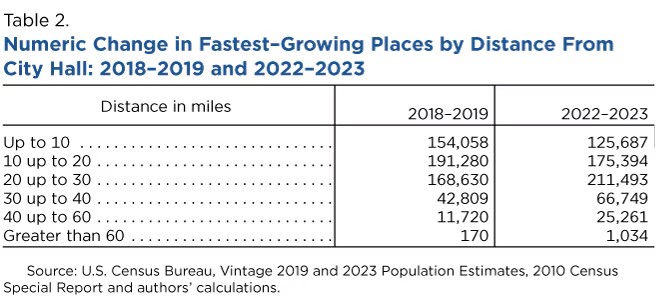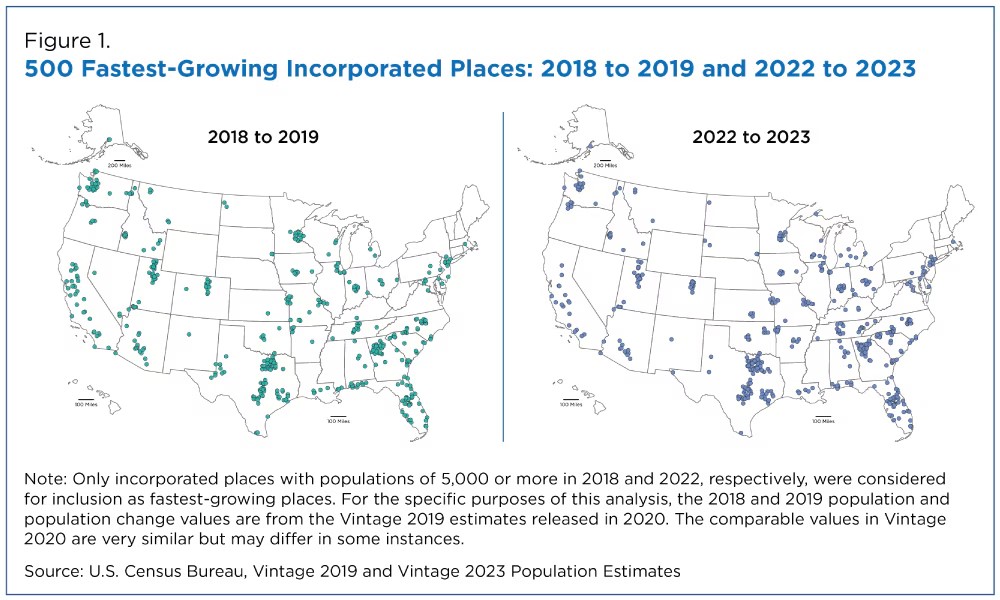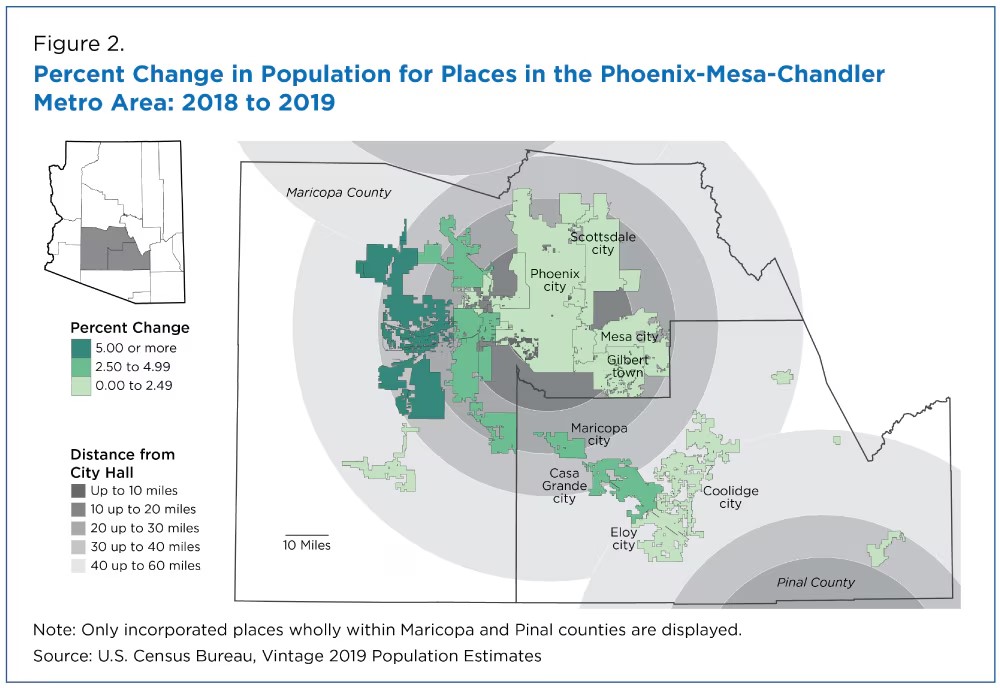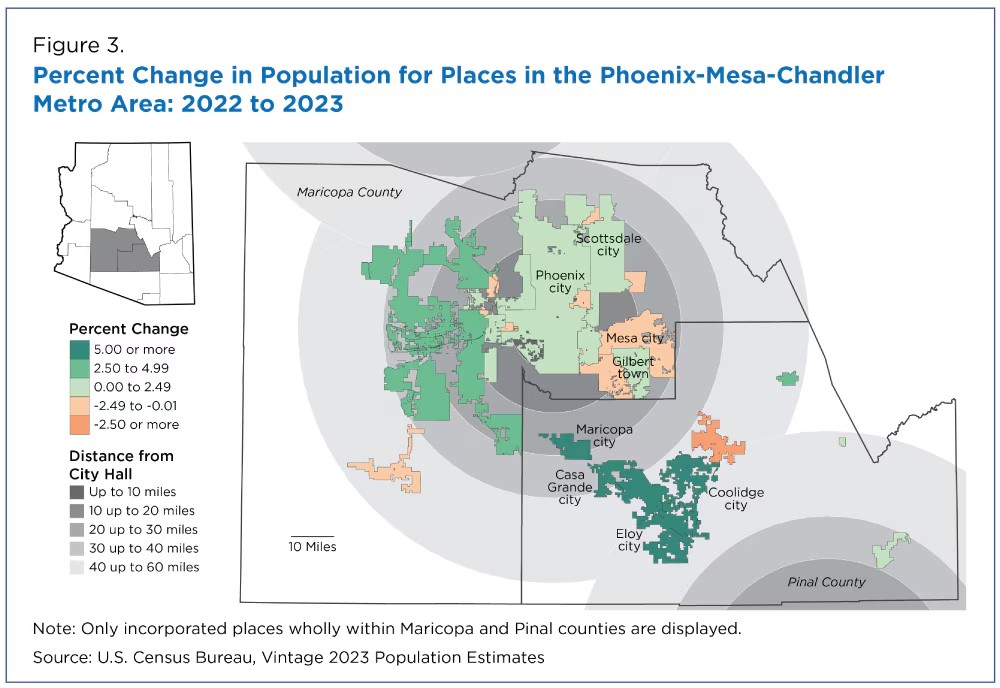More People Moved Farther Away from City Centers Since Covid-19 by Lindsay Spell and Marc Perry CENSUS.Gov I guess people did not like the threat of catching Covid in crowded areas so they are going to the suburbs. Even if they are in less populous areas, they still will have to get the vaccines and distance themselves. ~~~~~~~~ In a possible sign of the COVID-19 pandemic’s lasting impact, the country’s fastest-growing places are increasingly likely to be far-flung exurban communities on the outer margins of metro areas. This reveal according to July 1, 2023, population estimates released today. Fewer of the fastest-growing places between 2022 and 2023 were inner suburbs than in 2019 before the pandemic. More were on the far
Topics:
Angry Bear considers the following as important: Avoid Pandemics, Hot Topics, US EConomics
This could be interesting, too:
NewDealdemocrat writes JOLTS revisions from Yesterday’s Report
Joel Eissenberg writes No Invading Allies Act
Bill Haskell writes The North American Automobile Industry Waits for Trump and the Gov. to Act
Bill Haskell writes Families Struggle Paying for Child Care While Working
More People Moved Farther Away from City Centers Since Covid-19
by Lindsay Spell and Marc Perry
CENSUS.Gov
I guess people did not like the threat of catching Covid in crowded areas so they are going to the suburbs. Even if they are in less populous areas, they still will have to get the vaccines and distance themselves.
~~~~~~~~
In a possible sign of the COVID-19 pandemic’s lasting impact, the country’s fastest-growing places are increasingly likely to be far-flung exurban communities on the outer margins of metro areas. This reveal according to July 1, 2023, population estimates released today.
Fewer of the fastest-growing places between 2022 and 2023 were inner suburbs than in 2019 before the pandemic. More were on the far outskirts of metro areas . . . 30, 40 and even more than 60 miles away from the largest city’s downtown.
Luke Rogers, a demographer in the Census Bureau’s Population Division . . .
“While the Census Bureau doesn’t define exurbs, we tend to think of them as far outer suburbs of metro areas, and they often have a mix of urban and rural character. Exurbs have sometimes been among the most rapidly growing communities. This appears to be even more true now than before the pandemic.”
High Housing Costs and More Remote Work are Possible Reasons
Multiple factors are likely behind the increased growth of exurbs.
Among them: Rising housing costs after the start of the pandemic, driving some people farther away from cities toward exurbs in search of cheaper homes.
Greater opportunities to work from home also likely contributed. Before the pandemic, telework and remote work options were much less common. Rogers adds . . .
“With many more people in working ages now able to work from home at least some of the time, it’s likely that some people are more willing to live farther away from their place of employment than they would have in the past.”
Fastest-Growing Places Before and After the Pandemic
The 500 U.S. cities with the largest percentage increases in population in 2018-2019 and in 2022-2023 were in all four regions. But more than 4 out of 5 were in the South or West. Nearly all were inside a metro or micro area (Figure 1).
One of the 500 fastest-growing cities from 2018 to 2019 and three from 2022 to 2023 were not in a metro or micro area.
Calculating Distances from Downtown
Using an approach outlined in a 2010 Census Special Report on Core Based Statistical Areas, we defined “downtown” as the location of city hall in the largest city in a metro or micro area. We then calculated the distance from the center of each of the 500 places to that point.
The distance bands used were:
- Up to 10 miles from city hall.
- 10 up to 20 miles away.
- 20 up to 30 miles away.
- 30 up to 40 miles away.
- 40 up to 60 miles away.
- Greater than 60 miles from city hall.
There were more exurbs — places as far as 60-plus miles outside a metro area’s largest city. They were among the nation’s fastest-growing places in 2023 than in 2019, the year before the pandemic hit. (Table 1).
Fast growing places within 10 to 20 miles of the city decreased. There were fewer (103 compared to 125) fast-growing places within a 10-mile radius and a 10-to-20-mile radius (157 compared to 175).

Numeric population change was similar: collectively, population gains increased in the areas farthest out and slowed within 20 miles of the city center.

Booming Exurbs in Phoenix Metro Area
The Phoenix-Mesa-Chandler AZ metro area demonstrates the prominence of these new exurban boomtowns.
The metro area, which consists of Maricopa and Pinal counties, has grown steadily in recent decades reaching 5 million and becoming the nation’s 10th largest metro area. And while the metro area grew at a fast clip during both periods (2018-2019 and 2022-2023), exurbs increasingly contributed to that growth in the latter years.
Figures 3 and 4 show the percentage change in population for cities in the metro area. Growth in Phoenix itself dropped from 1.6% to 0.4% and similar slowdowns occurred in many of its closer-in suburbs such as Scottsdale (1.4% to 0.6%), Mesa (2.0% to -0.1%), and Gilbert (1.7% to 0.1%).
Yet growth rates in some of the more distant suburbs south of the city eclipsed already high rates of growth in 2018-19:
- Maricopa’s rapid 4.2% increase from 2018 to 2019 accelerated to a 7.1% increase last year.
- Casa Grande’s 2.8% increase swelled to 6.1%.
- Coolidge’s 1.6% increase surged to 9.4% growth last year.
- Eloy, more than 60 miles south of Phoenix city hall, was up 8.6% compared to a 1.5% increase in the year before the onset of the pandemic.
All told, these four exurbs contributed fully one-third of the entire metro area’s population growth last year, compared to just 4% from 2018 to 2019.
Temporary Blip or Enduring Phenomenon?
Patterns of population growth and distribution regularly evolve, and it is too soon to tell whether the recent surge of exurban growth is a temporary blip or a more enduring phenomenon.
Demographers and geographers will continue to monitor the spatial dimensions of population growth and decline for the nation’s 19,000-plus cities and towns for insights.
Credits: Lindsay Spell is a geographer and Marc Perry is a senior demographer in the Census Bureau’s Population Division.



